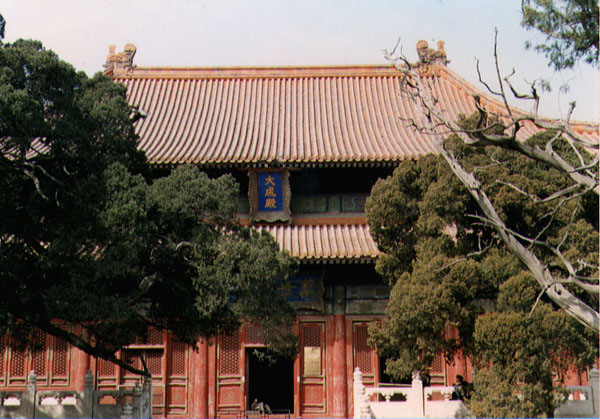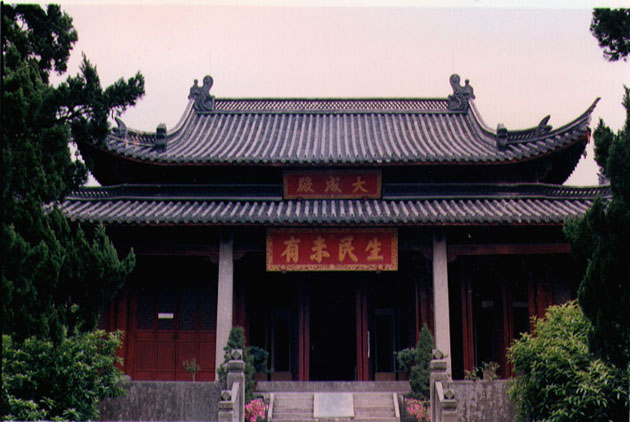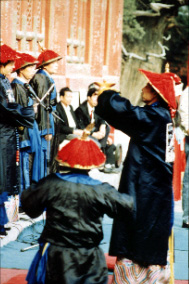

The Hall of Great Completion, Beijing
The first state temple devoted to Kongzi was built in the Liu-Song, which ruled over south China from 420 to 479. The Confucius temple in Bejing was first built in 1302, and was periodically repaired and rebuilt during the Ming (1368-1644) and Qing (1644-1911) dynasties. The Hall of Great Completion (Da cheng dian) is situated northeast of the Forbidden City.
Beginning in the Tang era, and particularly from Song times on, the state sacrifices to Confucius in the capital became increasingly complex and closely regulated by an official liturgy. When the founder of the Southern Song dynasty reestablished the capital in Lin'an (modern Hangzhou), an imperial Confucius Temple was constructed.

Present-day Confucius Temple, Quzhou, Zhejiang
Kongzi's forty-eighth generation descendant, Duke Kong Duanyou, followed the Song emperor, and established the southern Kong lineage. By 1136 the Kongs settled in Quzhou, Zhejiang, where they converted the local school temple into a temple operated by Kongzi's descendants. Later a family temple honoring Kongzi was established at a nearby lake. Around 1279, when the Southern Song fell, this temple was destroyed by fire, and was not rebuilt until 1407. The present-day Quzhou Confucius temple was moved to its current location in 1520.
Besides promoting a specific curriculum in the examination halls, the court also articulated its understanding of Confucian orthodoxy in a temple called the Kong temple, or the Temple of Culture. Here the spirits of Kongzi, his disciples, and later canonical exegetes and "transmitters of the Way" were enshrined and received sacrifices from representatives of the emperor. The question of which Confucians of later ages would be enshrined in the temple was controversial because it raised such issues as which commentaries on the Confucian canon were acceptable and, by the Song, who was believed to have received the true transmission of the Dao from Kongzi and Mengzi (Mencius). A basic chronology of enshrinement shows the gradual canonization of the Dao School version of the Confucian tradition, beginning in the 1240s and particularly by Ming times.

Reenactment of the sacrifice to Confucius, Beijing
In addition to hosting sacrifices, the Confucius Temple also served to enshrine Confucian teachings and doctrines. After it integrated the cult of Confucius into the imperial pantheon in the Tang dynasty (618 - 907), civil officials never ceased to debate the cult's meaning. In the early years of the cult, the court wavered on the central question of who was its principal sage, for, perhaps surprisingly, Confucius did not always hold this status. In subsequent years the court also added spirit tablets of other scholars, in effect endorsing the doctrines they taught. As a cult devoted to the spirits of men of surpassing classical learning, its rituals were necessarily bound up with the curriculum used to educate men preparing for civil examinations based on the Confucian Classics. One hundred ninety-eight carved stone tablets that still stand in front of the main gate of the Temple in Beijing best illustrate the Confucius Temple's integral connection with the examination system: they bear over fifty thousand names of men who passed the highest examination beginning in 1313, the date of the first examination to be held in the capital city of Beijing, to 1904, when the last civil examination was held there. The Libationer of the Directorate of Education led the new degree-holders who had passed the Palace Examination to the Temple to pay obeisance to the Supreme Sage.
According to most accounts, a temple honoring Kongzi was built in his hometown in 478 B.C. (17th year of Duke Ai of Lu), a year after his death. The sources suggest that, since the early years of this temple, the spirits of Kongzi and his disciples were represented with wall paintings and clay or wooden statues. After years of court debate, it was decided in 1530 that these spirits would not be represented by an iconic image of his likeness in the imperial temples in the capital and other bureaucratic locations. Opponents of iconic representations of Kongzi argued that such statues copied Buddhist practices of temple worship and also tended to confuse ritual ideas in ancestral sacrifice. They argued that imperial temples were constructed to honor Kongzi's teachings, not just the spirit of the flesh-and-blood man. The statues of Kongzi were removed from official temples, but they remained in the temples operated by Kongzi's family descendants, such as this statue of Kongzi in the Main Hall of Great Completion of the Confucius Temple in Qufu.

Shrine to Shuliang He, Qufu, Shangdong
Evidence suggests that as early as the eleventh century, Confucius temples had rooms to pay sacrifices to Confucius' father Shuliang He, and in 1048, a hall was built for this purpose. During the Yuan and Ming dynasties, ritualists explored the connection between the family cult of Confucius' descendants and the state cult of Confucius. When Shuliang He was posthumously honored as Duke who Gave Birth to the Sage, shrines called the Shrine for the Duke who Gave Birth to the Sage (Qisheng ci) were constructed to honor Confucius' father. The shrine in Qufu pictured here, was located immediately west of the Hall of Great Completion in 1729. The Qufu shrine has fallen into disrepair and is currently undergoing renovation; pictured here is the spirit statue of Shuliang He.





